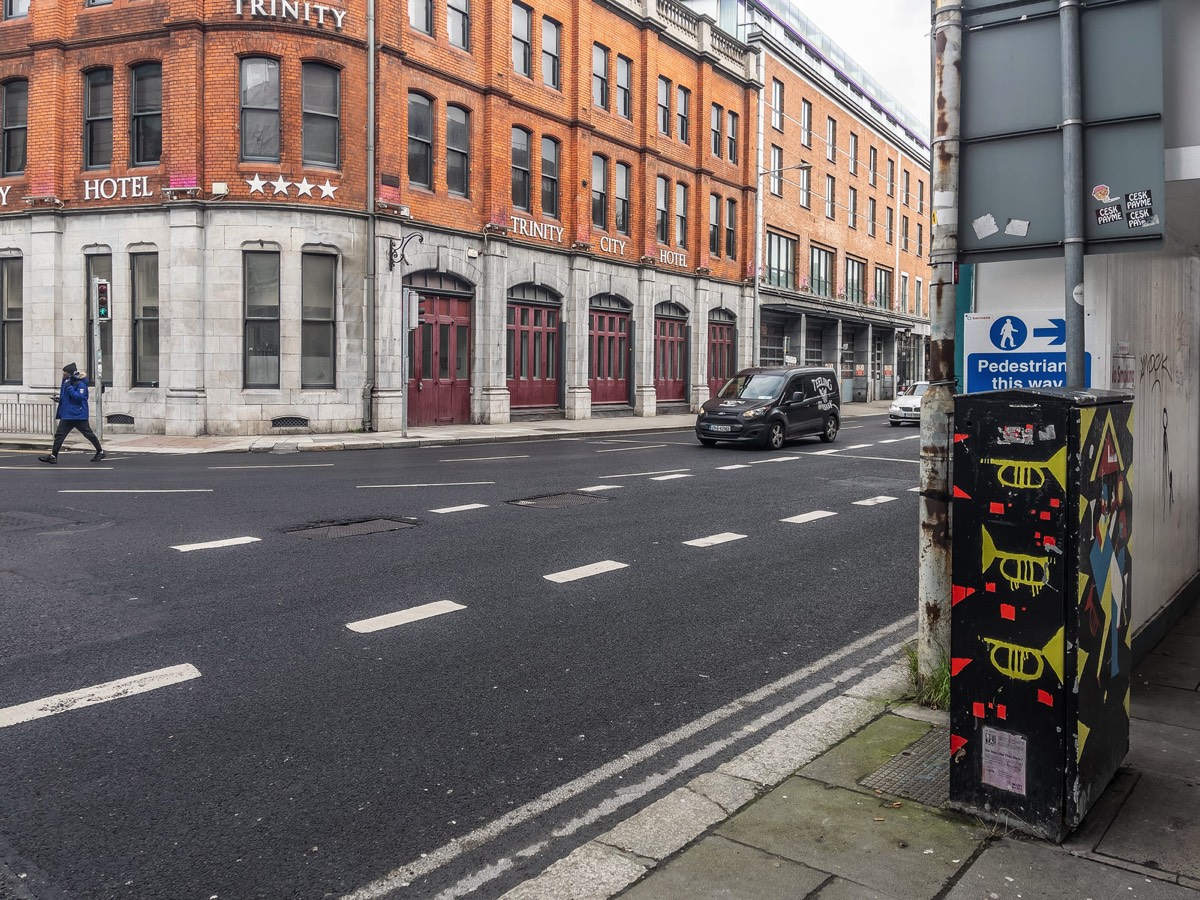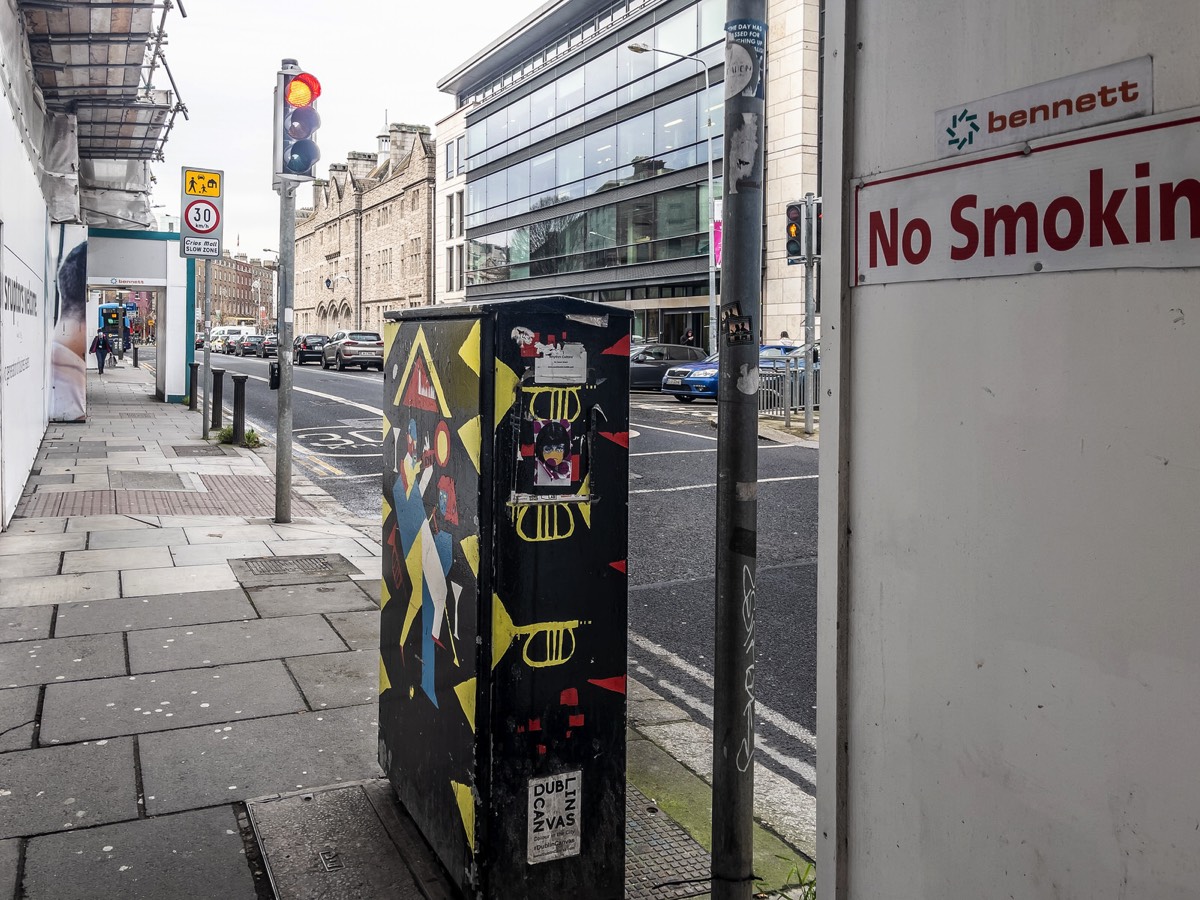PAINT-A-BOX STREET ART ON PEARSE STREET
The street is named after the Irish revolutionaries, Patrick Pearse and his brother William. It was previously called Great Brunswick Street after the House of Brunswick-Lüneburg, Hanover line.
The Dublin Oil Gas Company was established in 1824 with its main premises on Great Brunswick Street. This eventually became the Academy Cinema. The Brunswick and Shamrock Pneumatic Cycle Factory was at No. 2. The Lyceum Theatre planned to build a new building on Great Brunswick Street at its junction with Tara Street. Plans were submitted in 1884 for a 2,500 capacity venue, but this was later abandoned.
The western end of Pearse Street meets College Street near Townsend Street. Here, on the northern side, there is a Garda station, designed by Andrew Robinson and opened in 1912. This is followed by the old headquarters of the Dublin Fire Brigade at the Central Fire Station, which opened on 13 December 1907. The building was designed by C. J. McCarthy an Itanlian-Romanesque style in red brick and cost £21,840. The premises closed in 1988, and was later was converted into apartments and a hotel.
Office buildings are on the southern side of the street, followed by Trinity College. The offices of the Department of Social Protection are on the site of the Queen's Theatre, Dublin. Another building of note is O'Neill's Pub, at No. 37, which dates from the 1850s and is still in the same ownership today.
St. Mark's church was constructed in 1729 in a classical style. It was purchased by Trinity College in 1971 and used as an additional library premises. It was sold to the Assemblies of God in 1987 and was renovated in the early 21st century as part of a Foras Áiseanna Saothair-backed youth training scheme.
The DART crosses Pearse street beside St. Mark's, and east of that is the former Antient Concert Rooms where W. B. Yeats’ play The Countess Cathleen was first performed 8 May 1899[8] and James Joyce won an award for singing at the Feis Ceoil 16 May 1904. No. 43 is the former Erasmus Smith Commercial and Civil Service School, a bank and pub bracket the junction with Lombard Street, with Trinity College and the railway station and Goldsmith Hall opposite each other on Westland Row.
St Andrew's Resource Centre is at Nos. 114-116 and provides various adult education programmes and day care for the elderly. It originally opened as a Roman Catholic school in 1897, accommodating 1,200 children. The school closed in 1972 and reopened in its current guise in 1989.
Further east along the street is the Pearse Street Public Library at Nos. 138-144, which has supported the Gilbert Library and the City Archives on its first floor since 2003. The building was designed by C. J. McCarthy and opened in 1909. It is constructed from Mount Charles sandstone and Ballinasloe limestone and built in a classical style. The building has been modified several times, and was extensively redesigned internally to support the City Archives.
Beyond the library, the street becomes residential. The Winter Garden is a set of apartments on the corner of Pearse Street and Erne Street. It was designed by Paul O'Dwyer and opened in 1999 and designed around an glazed internal street. Shortly beyond this is Pearse Square (formerly Queen Square). The square was constructed in 1839 but was slow to develop; there is still an undeveloped plot at the south east end by Pearse Street.
The eastern extent of Pearse Street is the MacMahon Bridge at Grand Canal Dock, where numerous high-tech offices and high-rise apartment buildings in an area dubbed Silicon Docks can be found. The street becomes Ringsend Road, and later Bridge Street around Ringsend Bridge, on its continuation into Dublin 4.
The Cuban embassy is located on this street.
The Dublin Oil Gas Company was established in 1824 with its main premises on Great Brunswick Street. This eventually became the Academy Cinema. The Brunswick and Shamrock Pneumatic Cycle Factory was at No. 2. The Lyceum Theatre planned to build a new building on Great Brunswick Street at its junction with Tara Street. Plans were submitted in 1884 for a 2,500 capacity venue, but this was later abandoned.
The western end of Pearse Street meets College Street near Townsend Street. Here, on the northern side, there is a Garda station, designed by Andrew Robinson and opened in 1912. This is followed by the old headquarters of the Dublin Fire Brigade at the Central Fire Station, which opened on 13 December 1907. The building was designed by C. J. McCarthy an Itanlian-Romanesque style in red brick and cost £21,840. The premises closed in 1988, and was later was converted into apartments and a hotel.
Office buildings are on the southern side of the street, followed by Trinity College. The offices of the Department of Social Protection are on the site of the Queen's Theatre, Dublin. Another building of note is O'Neill's Pub, at No. 37, which dates from the 1850s and is still in the same ownership today.
St. Mark's church was constructed in 1729 in a classical style. It was purchased by Trinity College in 1971 and used as an additional library premises. It was sold to the Assemblies of God in 1987 and was renovated in the early 21st century as part of a Foras Áiseanna Saothair-backed youth training scheme.
The DART crosses Pearse street beside St. Mark's, and east of that is the former Antient Concert Rooms where W. B. Yeats’ play The Countess Cathleen was first performed 8 May 1899[8] and James Joyce won an award for singing at the Feis Ceoil 16 May 1904. No. 43 is the former Erasmus Smith Commercial and Civil Service School, a bank and pub bracket the junction with Lombard Street, with Trinity College and the railway station and Goldsmith Hall opposite each other on Westland Row.
St Andrew's Resource Centre is at Nos. 114-116 and provides various adult education programmes and day care for the elderly. It originally opened as a Roman Catholic school in 1897, accommodating 1,200 children. The school closed in 1972 and reopened in its current guise in 1989.
Further east along the street is the Pearse Street Public Library at Nos. 138-144, which has supported the Gilbert Library and the City Archives on its first floor since 2003. The building was designed by C. J. McCarthy and opened in 1909. It is constructed from Mount Charles sandstone and Ballinasloe limestone and built in a classical style. The building has been modified several times, and was extensively redesigned internally to support the City Archives.
Beyond the library, the street becomes residential. The Winter Garden is a set of apartments on the corner of Pearse Street and Erne Street. It was designed by Paul O'Dwyer and opened in 1999 and designed around an glazed internal street. Shortly beyond this is Pearse Square (formerly Queen Square). The square was constructed in 1839 but was slow to develop; there is still an undeveloped plot at the south east end by Pearse Street.
The eastern extent of Pearse Street is the MacMahon Bridge at Grand Canal Dock, where numerous high-tech offices and high-rise apartment buildings in an area dubbed Silicon Docks can be found. The street becomes Ringsend Road, and later Bridge Street around Ringsend Bridge, on its continuation into Dublin 4.
The Cuban embassy is located on this street.


As an Amazon Associate I earn from qualifying purchases
You will find links to buy products from Amazon, Google and other partners. If you click on these links, you’ll find that the URL includes a small extra piece of text which identifies that the click came from my websites. This text is an affiliate code, and it means that I get a small percentage of the money you spend if you choose to buy that product, or, in some cases, other products from the site soon after. These affiliate links help pay the costs of producing my websites and ensure that the content is free to you.